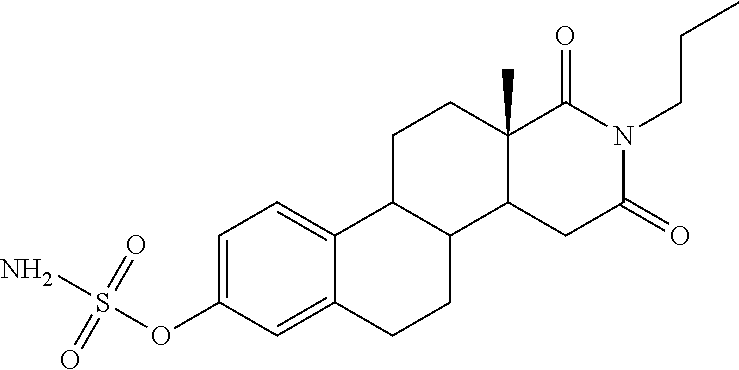Method of treatment of EGFR inhibitor toxicity
a technology of egfr inhibitor and toxicity, which is applied in the field of egfr inhibitor treatment and the field of egfr inhibitor toxicity treatment, can solve the problems of affecting the treatment effect, so as to increase the efficacy of egfr inhibitor treatment and reduce the severity of toxicity
- Summary
- Abstract
- Description
- Claims
- Application Information
AI Technical Summary
Benefits of technology
Problems solved by technology
Method used
Image
Examples
example 1
The Effect of STX64 on Papulopustular Rash Associated With EGFR Inhibitor Therapy for Advanced Colorectal Cancer
[0115]The effect of administration of STS inhibitors on papulopustular rash in cancer patients undergoing treatment with EGFR inhibitors can be assessed in a randomised, placebo-controlled Phase 2 Study of the STS inhibitor, STX64 (also known as BN83495 or 667-coumate), in patients receiving an EGFR inhibitor for the treatment of advanced colorectal cancer.
[0116]Study Design
[0117]Patients with advanced colorectal cancer receiving single agent cetuximab or panitumimab are randomised to STX64 or placebo in a double-blind randomised phase 2 study.
[0118]Eligibility / Exclusion Criteria[0119]a) Advanced colorectal cancer able to receive cetuximab or panitumimab.[0120]b) Tumour genotype is k-ras and / or B-raf wild-type.[0121]c) Acceptable biomedical and haematological baseline values.[0122]d) Measureable disease.[0123]e) Not receiving other hormonally active agents.[0124]f) No hist...
example 2
[0136]Grading Papulopustular Rash
[0137]The severity of the papulopustular rash can be graded using the National Cancer Institute's (NCI) common terminology criteria for adverse events (CTCAE) (Gridelli et al 2008; CTCAE version 3.0: ) Adverse events are graded on a scale of 1 to 5, with grade 1 being the mildest and least symptomatic. A grade 3 papulopustular rash is defined as a “symptomatic and disfiguring” rash. The rash typically occurs on a limited extent of skin but may be dose-limiting, with respect to EGFR inhibitors, when painful, confluent, or superinfected. The NCI's CTCAE can also be used to grade other dermatologic problems that may occur with EGFR inhibitors (e.g., hair loss / alopecia, dry skin, nail changes, pruritus / itching, telangiectasias).
example 3
The Effect of STX64 (BN83495) on Papulopustular Rash Associated With EGFR Inhibitor Therapy for Non-Small Cell Lung Cancer
[0138]The effect of administration of STS inhibitors on papulopustular rash in cancer patients undergoing treatment with an oral EGFR inhibitor can be assessed in a pilot study involving administration of the EGFR inhibitor (erlotinib or gefitinib) and BN83495, in patients receiving the EGFR inhibitor for the treatment of non-small cell lung cancer (NSCLC).
[0139]The study will enable determination of the frequency and grade of papulopustular rash in NSCLC patients receiving the the EGFR inhibitor and BN83495; the frequency and grade of additional cutaneous side effects and the changes in oestrogen and androgen-related biochemistry and EGFR inhibitor blood levels associated with the treatment.
[0140]Pharmacokinetics
[0141]In non-clinical studies BN83495 showed rapid absorption and good oral bioavailability (60 to 96% in rats and 77 to 90% in dogs). In 6-month repeat...
PUM
| Property | Measurement | Unit |
|---|---|---|
| Toxicity | aaaaa | aaaaa |
Abstract
Description
Claims
Application Information
 Login to View More
Login to View More - R&D
- Intellectual Property
- Life Sciences
- Materials
- Tech Scout
- Unparalleled Data Quality
- Higher Quality Content
- 60% Fewer Hallucinations
Browse by: Latest US Patents, China's latest patents, Technical Efficacy Thesaurus, Application Domain, Technology Topic, Popular Technical Reports.
© 2025 PatSnap. All rights reserved.Legal|Privacy policy|Modern Slavery Act Transparency Statement|Sitemap|About US| Contact US: help@patsnap.com


